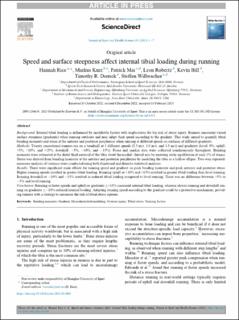| dc.contributor.author | Rice, Hannah | |
| dc.contributor.author | Kurz, Markus | |
| dc.contributor.author | Mai, Patrick | |
| dc.contributor.author | Robertz, Leon | |
| dc.contributor.author | Bill, Kevin | |
| dc.contributor.author | Derrick, Timothy R. | |
| dc.contributor.author | Willwacher, Steffen | |
| dc.date.accessioned | 2023-10-23T13:02:24Z | |
| dc.date.available | 2023-10-23T13:02:24Z | |
| dc.date.created | 2023-05-25T12:49:02Z | |
| dc.date.issued | 2023 | |
| dc.identifier.citation | Journal of Sport and Health Science. 2023, Artikkel 03.004. | en_US |
| dc.identifier.issn | 2095-2546 | |
| dc.identifier.uri | https://hdl.handle.net/11250/3098156 | |
| dc.description | This is an open access article under the CC BY-NC-ND license (http://creativecommons.org/licenses/by-nc-nd/4.0/). | en_US |
| dc.description.abstract | Background: Internal tibial loading is influenced by modifiable factors with implications for the risk of stress injury. Runners encounter varied surface steepness (gradients) when running outdoors and may adapt their speed according to the gradient. This study aimed to quantify tibial bending moments and stress at the anterior and posterior peripheries when running at different speeds on surfaces of different gradients.
Methods: Twenty recreational runners ran on a treadmill at 3 different speeds (2.5 m/s, 3.0 m/s, and 3.5 m/s) and gradients (level: 0%; uphill: +5%, +10%, and +15%; downhill: –5%, –10%, and –15%). Force and marker data were collected synchronously throughout. Bending moments were estimated at the distal third centroid of the tibia about the medial–lateral axis by ensuring static equilibrium at each 1% of stance. Stress was derived from bending moments at the anterior and posterior peripheries by modeling the tibia as a hollow ellipse. Two-way repeated-measures analysis of variance were conducted using both functional and discrete statistical analyses.
Results: There were significant main effects for running speed and gradient on peak bending moments and peak anterior and posterior stress. Higher running speeds resulted in greater tibial loading. Running uphill at +10% and +15% resulted in greater tibial loading than level running. Running downhill at –10% and –15% resulted in reduced tibial loading compared to level running. There was no difference between +5% or –5% and level running.
Conclusion: Running at faster speeds and uphill on gradients ≥+10% increased internal tibial loading, whereas slower running and downhill running on gradients ≥–10% reduced internal loading. Adapting running speed according to the gradient could be a protective mechanism, providing runners with a strategy to minimize the risk of tibial stress injuries. | en_US |
| dc.language.iso | eng | en_US |
| dc.subject | bending moments | en_US |
| dc.subject | gradient | en_US |
| dc.subject | musculoskeletal modeling | en_US |
| dc.subject | overuse injury | en_US |
| dc.subject | tibial stress | en_US |
| dc.subject | training factors | en_US |
| dc.title | Speed and surface steepness affect internal tibial loading during running | en_US |
| dc.type | Peer reviewed | en_US |
| dc.type | Journal article | en_US |
| dc.description.version | publishedVersion | en_US |
| dc.rights.holder | © 2023 Published by Elsevier B.V. on behalf of Shanghai University of Sport | en_US |
| dc.source.pagenumber | 7 | en_US |
| dc.source.journal | Journal of Sport and Health Science | en_US |
| dc.identifier.doi | 10.1016/j.jshs.2023.03.004 | |
| dc.identifier.cristin | 2149234 | |
| dc.description.localcode | Institutt for fysisk prestasjonsevne / Department of Physical Performance | en_US |
| dc.source.articlenumber | 03.004 | en_US |
| cristin.ispublished | true | |
| cristin.fulltext | original | |
| cristin.qualitycode | 1 | |
